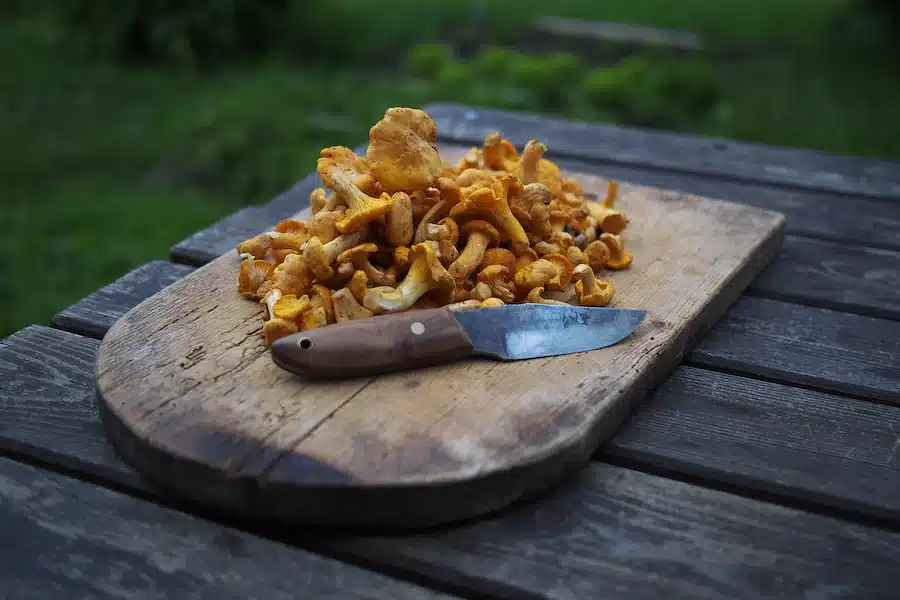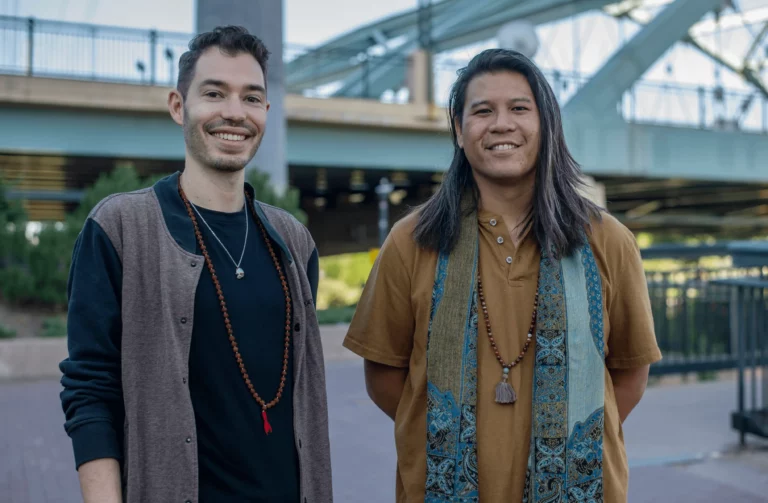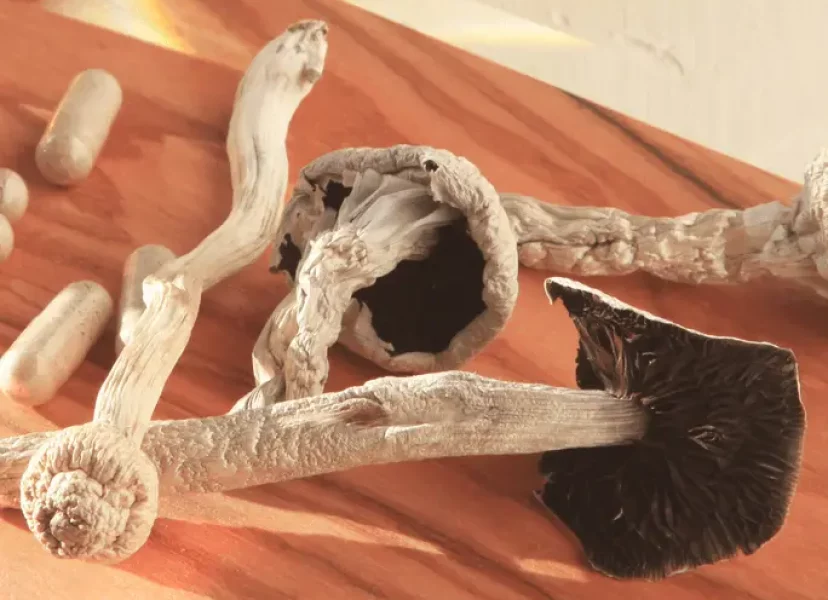Even if you’re not familiar with ketosis, you’re probably aware that when and what you eat can impact the effects of substances and medicines you take.
Not only can fasting alter the intensity of a psychedelic experience, but it can also impact when and how a trip begins and feels. So, can ketosis or fasting impact the psychedelic experience? Absolutely.
How the psychedelic experience is impacted by fasting is another story. A quick browse on psychedelic forums or talking to psychonaut friends will likely expose you to this idea of fasting before a trip.
In fact, the two have gone hand in hand for millennia, and the combination of the two is still a part of many ayahuasca and mushroom ceremonies in many indigenous and shamanic rites (known as a pre-ritual dieta).
When done properly, fasting may produce enjoyable effects and even help mitigate nausea during your intentional psychedelic journey.
However, both ketosis and fasting come with their own set of risks, as does combining them with any substance. If you’re new to the idea, start slow, and be sure to do proper research and consult an expert beforehand. This article is a great first step! Let’s dive in.
Key Takeaways
- Ketosis is a metabolic state where the body, lacking glucose for energy, begins metabolizing fats, resulting in the accumulation of ketones. This state can be achieved through fasting or through being on a ‘keto’ diet.
- Despite known anti-inflammatory properties, caution is warranted due to its potential nutrient deficiencies. Striking the right balance and ensuring sufficient nutrient intake is essential.
- The combination of fasting, ketosis, and psychedelics holds a fascinating synergy. Factors such as timing, dosage adjustments, and nutritional choices should be approached cautiously to optimize the effects.
- Psychedelic Passage: Your Psychedelic Concierge — The easy, legal way to find trustworthy psilocybin guides, facilitators and psychedelic-assisted therapy near you in the United States.
Download Our Free Psilocybin Sourcing Guide
For harm-reduction purposes, we provide links to online psilocybin vendors, local stores, delivery services, and spore vendors for growing your own medicine at home.
What is Ketosis?
Ketosis is when your body is short on glucose for energy, so it begins to metabolize (burn) fats instead. The name ‘ketosis’ comes from the fact that this process causes a build-up of acids called ketones.
There are two ways ketosis is possible: through fasting or by following a ketogenic diet (often called ‘keto’). The ketogenic diet was developed in 1921 and was initially a way to treat epilepsy.
Now, it’s a popular health trend used to aid in rapid weight loss, and its known anti-inflammatory properties may help with pain relief (Masino & Ruskin, 2014).
However, it’s important to note that the ketogenic diet can be restrictive and lack certain critical vitamins and nutrients typically found in a balanced diet.
Therefore, it’s essential to ensure adequate intake of necessary nutrients, such as vitamins, while following a ketogenic diet.
According to a 2023 evaluative review by Masons and colleagues, a standard ketogenic diet will have roughly the following ratios:
- 55-60% fat
- 30-35% protein
- 5-10% carbs
- 0% sugar
We’ll leave you to the diet and nutrition books to learn more, but essentially, a ketogenic diet is high in fats, moderate in proteins, and includes very little carbohydrates.
How Can Ketosis Impact the Psychedelic Experience?
When we look at ketosis and how it impacts an experience with psychedelics, we have to realize that everyone experiences psychedelics differently and everyone who combines ketosis with psychedelics will also have different outcomes.
While we can make assumptions based on anecdotal information and what we know about how ketosis impacts the body, there is no way of knowing how ketosis + psychedelics will affect you specifically.
As you’ll see, many people report differences when they combine ketosis and different psychedelic substances, with most reports claiming heightened effectiveness of the psychedelic and a positive, more comfortable experience.
Ketosis & LSD
Interestingly, individuals have reported that a standard keto diet results in a diminished effect of LSD. Why could this be? Well, the reason that ketosis happens in the first place is the result of a reduction of available glucose in the body.
LSD has been observed to significantly increase the breakdown of glucose as it’s metabolized (Torre & Vergani, 2003), and if glucose plays a key role in the body’s processing of LSD, it’s possible that in the absence of adequate glucose, LSD breaks down differently.
Looks like there’s science behind the rumors in the psychedelic community that “glucose is your best friend during a trip.”
Some have reported that a simple remedy of 1-3 tablespoons of honey will boost the effects of LSD, especially if you’ve been fasting.

Ketosis & Psilocybin Mushrooms
Psilocybin and ketosis have an interesting history. Terrance McKenna, the author of Food of the Gods, believed in what he called the “Stoned Ape Theory.”
This theory involves the evolution of Homo erectus to Homo sapiens and revolves around one thing—magic mushrooms.
In this theory, hunter-gatherers evolved after stumbling across psychedelic mushrooms, which contributed to the higher levels of consciousness that made humans what we are.
What’s interesting is that these hunter-gatherers were probably unknowingly consuming what we would refer to today as a “ketogenic diet” in tandem with medicinal mushrooms.
What’s even more interesting is that if McKenna’s theory is right, humans have continued combining ketogenic diets and psilocybin for around a million years.
When the body is in a stage of ketosis, users have found that the effects of psilocybin are enhanced.
One user reported following a vegan keto diet and was able to experience the effects of a standard dose of psilocybin (3.5 grams) after only consuming 0.4 grams!
While this hasn’t been studied extensively, research would suggest that because the blood-brain barrier is more permeable on a ketogenic diet, psilocybin would also be able to pass through more effectively. (Hasselbalch et al., 1995).
Because the brain is permeable to any glucose and ketone bodies that pass through, psilocin (the psychoactive metabolite of mushrooms) also might hitch a ride and allow the user to feel more of the drug, even after less has been consumed.
Ketosis & MDMA (Molly)
While a semi-recent news article alerted the fact that being on a keto diet produced euphoria (Merino, 2014) similar to ‘ecstasy,’ that ecstasy referred to was ‘liquid ecstasy’ or the drug GHB.
However, there have been cases where citizen scientists have explored the combination of ketosis and another type of ecstasy—MDMA.
The effects of ketosis and MDMA are reportedly enjoyable. The body feels clean and the mind feels clear-headed. Like with psilocybin, the increased permeability in the blood-brain barrier will help someone feel stronger effects.
Around just a ⅓ of their normal dose could provide the same effects, and because the release of serotonin and dopamine will speed up metabolism, having enough glucose in the body to maintain proper brain function is key.
Many people recommend having electrolytes and snacks handy, like some fresh fruits (bear in mind you might not be that hungry).
And, to help with that serotonin crash, some keto-friendly and tryptophan-high snacks like cheese and nuts might be your best friend in the days before and after the experience.
Have a specific question about ketosis and psychedelics? Until deregulation can allow for more scientific research, the best source of knowledge is other people who have experienced psychedelics.
What About Fasting?
Fasting and ketosis are often combined, with intermittent fasting being one of the most popular options. One important distinction, however, is that it takes several days of fasting to lead to ketosis.
The ‘metabolic switch’ (where the body begins using fat instead of glucose for energy) typically takes place after 12 to 36 hours of water-only fasting.
While the hunter-gatherers in McKenna’s “Stoned Ape Theory” were thought to be eating ketogenic diets, they were also understood to undergo periods of extended fasting due to the unavailability of food sources.
And if this was how psychedelics were discovered—through an ancient relationship between humans and psychedelics—then perhaps this is why fasting has remained such a crucial part of many psychedelic practices.
When it comes to modern research on fasting, findings “suggest few or no adverse effects, and improvements in performance in some cognitive domains including executive function have been reported” (Anton et al., 2017).
That same analysis found: “In regards to physical performance…men demonstrated superior improvements in upper and lower body endurance…compared to the control group.”
Ancient civilizations and modern thinkers have used fasting alone to access different levels of consciousness, so it’s no wonder the effects are synergized in combination with psychedelics.
Even when doing psychedelics outside of a ceremonial setting, many users opt for fasting before the experience which can have extremely positive effects or, for others, awful ones.
Experimenting with tryptamine-containing psychedelics like DMT, 5-MeO-DMT, ayahuasca, or psilocybin after or during a fast results in a ‘clean’ experience (clean meaning with little to no adverse or unintended side effects).
In fact, some people will only use these substances after they’ve fasted for at least 24 hours, as many liken it to “letting go of what weighs you down in order to fly.”
Others feel great from just fasting alone, and psychedelic use is just an added benefit, but it’s important to note that taking psychedelics on a very empty stomach can lead to vomiting, stomach pain, exhaustion, discomfort, lightheadedness, or even fainting.
In most cases, these negative symptoms happen to people who have little experience with fasting.
If you are not accustomed to healthy fasting practices or very new to fasting, you may be depriving your body of necessary nutrients and subsequent energy to endure an intense psychedelic experience.
If ketosis and fasting are not for you, even waiting three to six hours since your last meal can help. For many people, just having an empty stomach assists the psychedelic experience.
With LSD, having a large meal before the trip resulted in only half of the orally ingested LSD being absorbed (Passie et al., 2008). Psilocybin and MDMA are the same, and users report feeling the drugs much less—or not at all—right after a meal.
There’s clearly a reason that people may choose to fast before a psychedelic experience. However, the main factor when it comes to a successful psychedelic experience after/during a fast is experience.
Safety Tips for Combining Fasting/Ketosis with Psychedelic Experiences:
- Familiarize Yourself: If you’re new to a keto diet or still adjusting it to your lifestyle, take some time before adding psychedelics to the mix.
- Understand Fasting: Fasting has its own risks. Experiment with it a few times before using it as preparation for a psychedelic trip.
- Seek Professional Advice: If you’re new to ketosis or fasting, consult a healthcare professional or discuss it with your doctor.
- Start Small: For fasting, begin with a few hours or a day at a time. No need to jump into a 14-day water fast right away.
- Adjust Psychedelic Dose: Expect that you may need less of the psychedelic substance if you’ve been fasting.
- Timing Matters: A few hours of fasting can be sufficient. Wait at least three to six hours after a meal to consume psychedelics. Opt for a healthier meal beforehand.
- Post-Trip Nutrition: Consider breaking your fast and eating towards the end or shortly after a trip. Your brain needs glucose; choose healthier sources like grapes, bananas, or dark chocolate.
- Keep Snacks Handy: You might forget about food during the experience. Have easy-to-consume snacks ready, like watermelon, melons, nuts, yogurt, or cottage cheese.
- Prepared Meals: Cooking might be challenging during a psychedelic experience. It’s safer to have an already-prepared meal or assistance from someone sober.
- Diet Matters: Depending on your diet, opt for a whole-grain pasta salad with spinach and hard-boiled eggs (non-ketogenic) or a leafy kale and spinach salad with chicken/tofu, nuts, and cheese (ketogenic). These can help with any serotonin deficits.
As always, psychedelic safety is the most important focus of any therapeutic psychedelic experience. And when you’re adding ketosis or fasting into the mix, you’ve got another element with their own set of risks.
While combining ketosis/fasting with psychedelics is generally a positive experience, that’s heavily based on the individual’s own experience with changes to their diet. Fasting itself can be a psychedelic journey on its own, so consider starting with just that!
Speak With a Trusted Psychedelic Therapy Provider Today
Hi there! We sincerely hope that you’ve found valuable takeaways that resonate with your current intentions. To explore research-based education, stay updated with psychedelic news, and benefit from practical how-to articles, we encourage you to head over to our resources page.
If you’re seeking personalized advice and are prepared to take the first step toward a therapeutic psychedelic experience, we invite you to book a consultation with our team of experienced psychedelic concierges.
This consultation is more than just a conversation; it’s an opportunity to be matched with a trustworthy local facilitator. You’ll be seamlessly connected to our rigorously vetted network of psychedelic guides, ensuring potential matches align with your needs.
Psychedelic Passage offers confidence and peace of mind by alleviating the burden of having to guess who’s right for you. If you want to discover how Psychedelic Passage can help you, we empower you to learn more about our services and check out client testimonials from those who’ve gone before you.
Your healing path is uniquely yours, and our commitment is to serve you at every juncture. Psychedelic Passage: Your Psychedelic Concierge — The easy, legal way to find trustworthy psilocybin guides, facilitators and psychedelic-assisted therapy near you in the United States.
Learn More About Our Network
- Book a Consultation Call
- Meet Our Referral Network
- Explore Frequently Asked Questions
- Watch Client Testimonials
- Is Psychedelic Passage Safe & Legit?
Connect With Psychedelic Passage
- Listen to our podcast on Spotify, Apple Podcasts, and iHeartRadio
- Subscribe to our Youtube Channel
- Follow us on Instagram, Reddit, Twitter, and Linked in for bite-sized updates and content.
Frequently Asked Questions
Q: Can a ketogenic diet impact the intensity of psychedelic experiences like LSD or psilocybin?
Yes, a ketogenic diet may affect the effects of psychedelics. For example, a high-fat, low-carb keto diet could potentially diminish the effects of LSD due to reduced glucose levels.
However, individual responses vary, and some users find the effects enhanced when combining ketosis and psilocybin.
Q: Is fasting necessary for a psychedelic experience, and how does it interact with ketosis?
Fasting before a psychedelic experience is not mandatory but is practiced to potentially enhance the effects. Fasting can induce ketosis, altering the body’s metabolism.
When combined with psychedelics, fasting may influence the intensity and duration of the experience, often producing a ‘cleaner’ encounter.
Q: Are there risks associated with combining ketosis, fasting, and psychedelics?
Yes, combining these elements carries risks. Fasting and ketosis can cause blood sugar fluctuations and potential electrolyte imbalances, which, when combined with psychedelics, may intensify the effects.
It’s crucial to start with smaller doses, stay hydrated, and consult a healthcare professional if uncertain.



